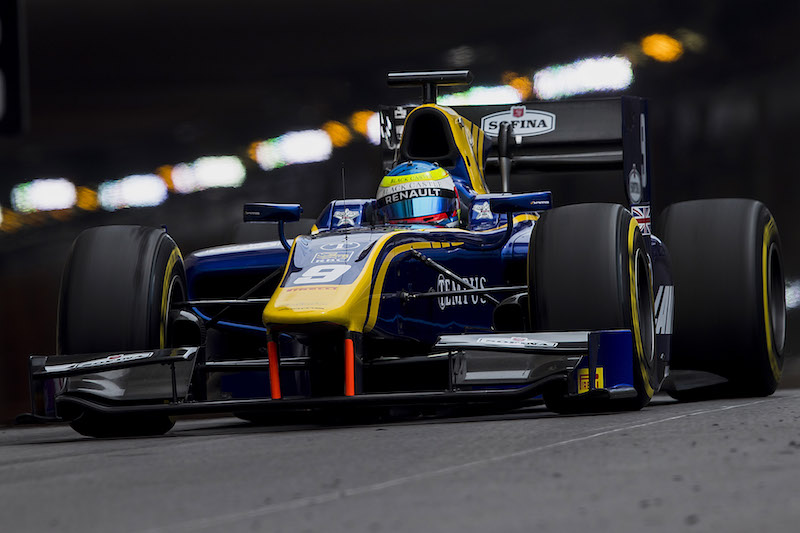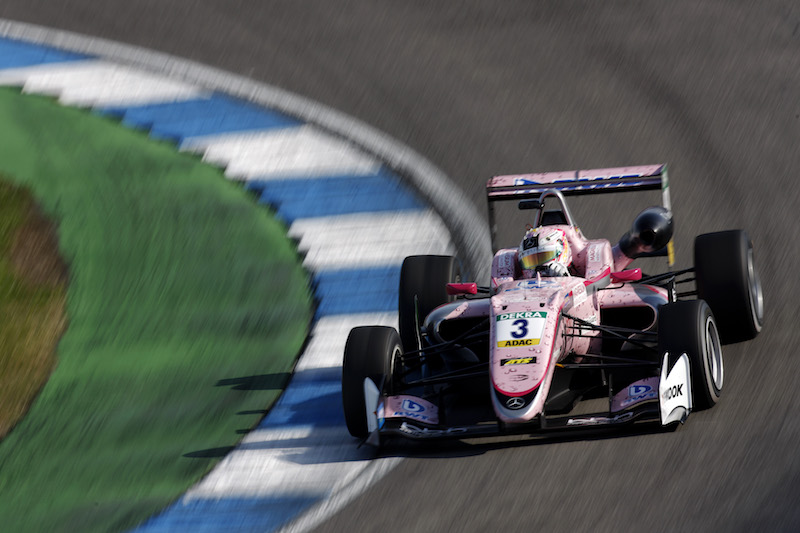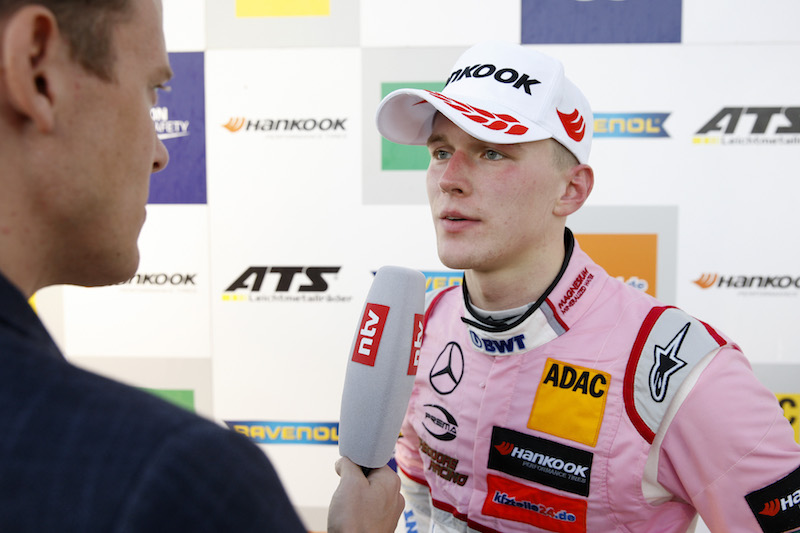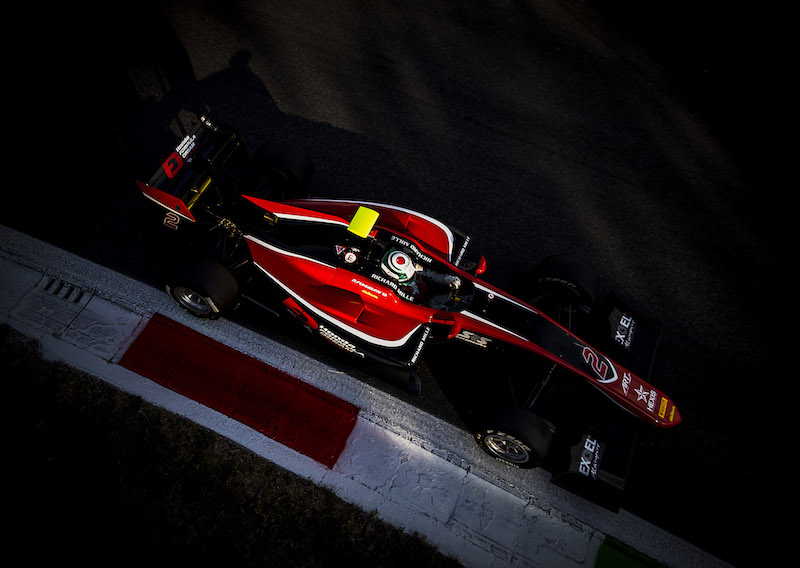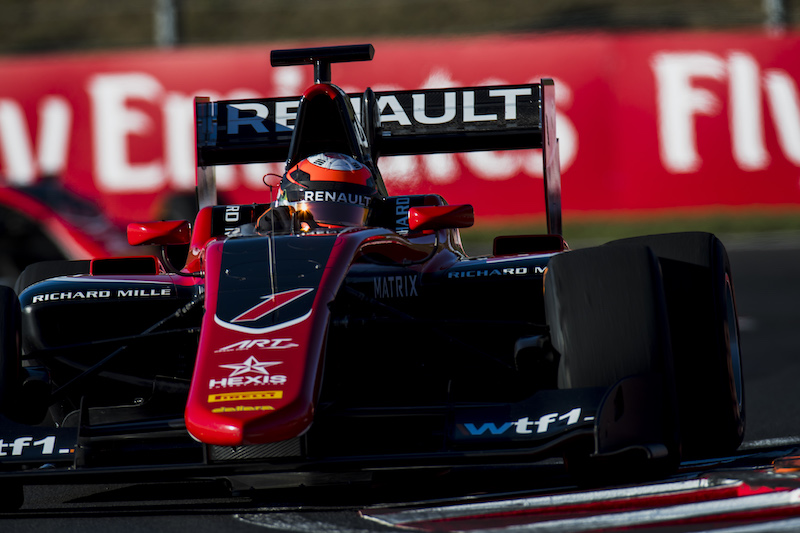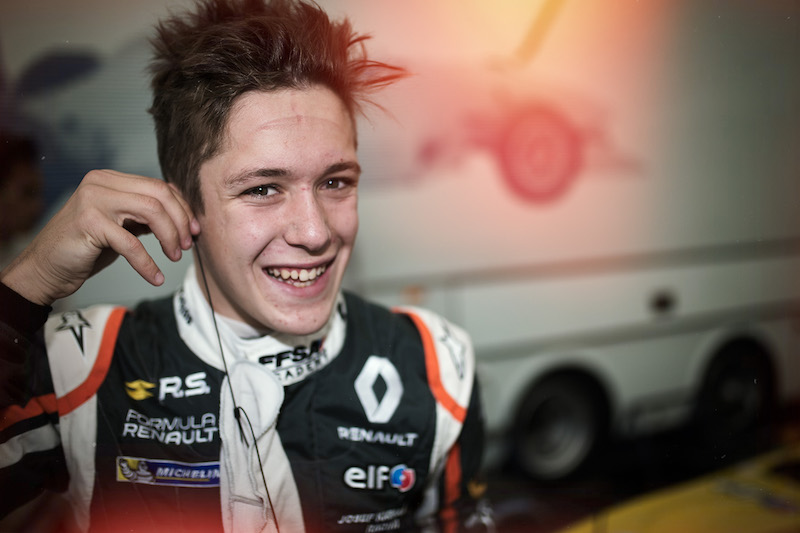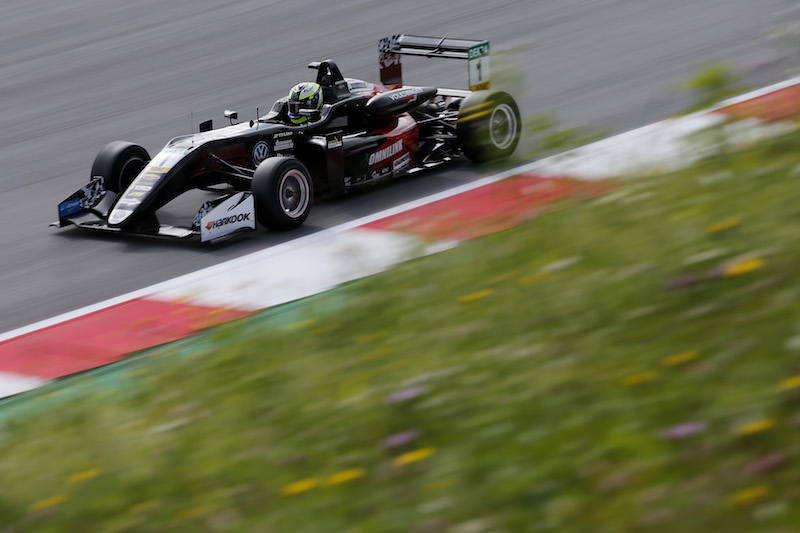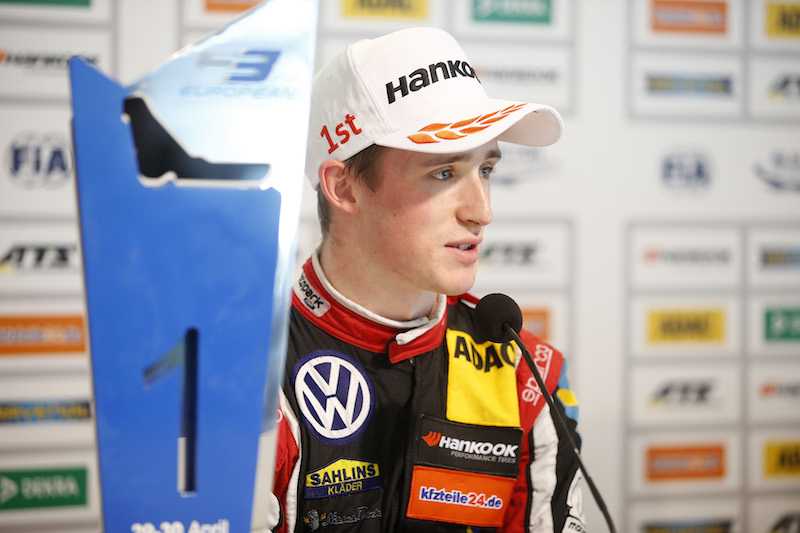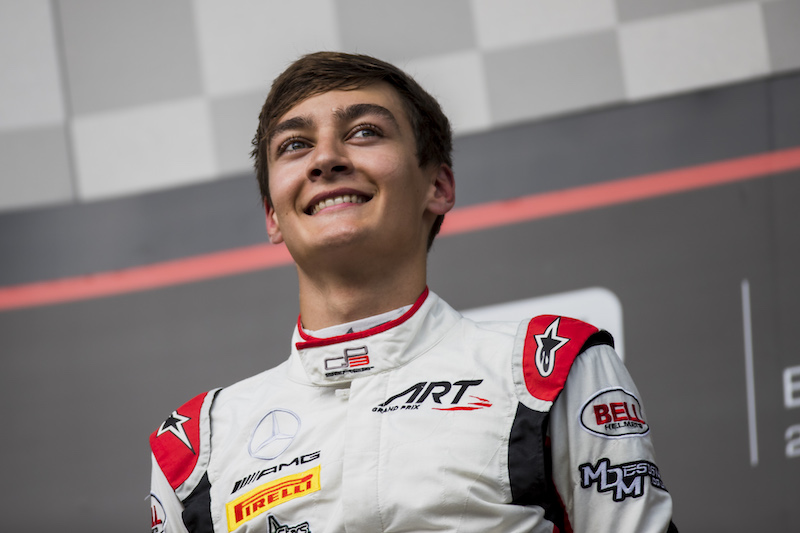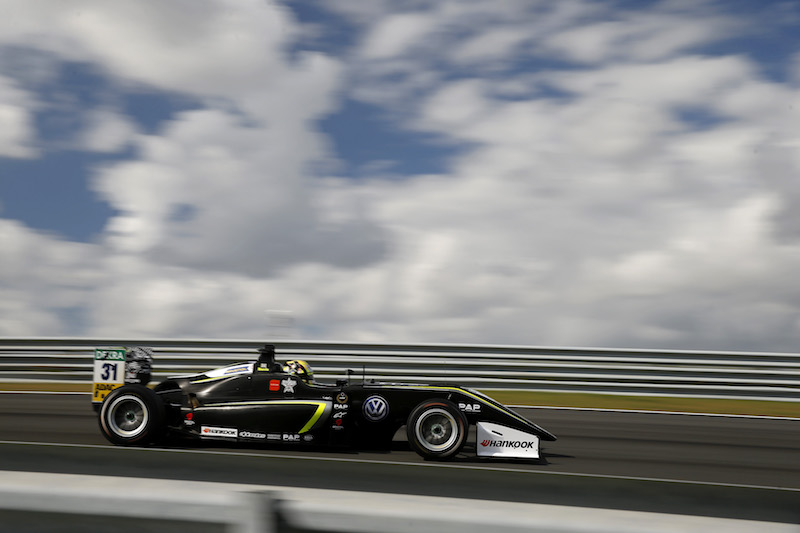We reveal our top 10 drivers in junior single-seater racing in 2017.
See also
Part 1: 50 to 41
Part 2: 40 to 31
Part 3: 30 to 21
Part 4: 20 to 11
10. Oliver Rowland
Up 17
Third in F2
Because of events out of his control, the final championship positions didn’t show it, but Rowland was the closest challenger to Charles Leclerc in Formula 2 this year.
The DAMS team he was driving for had come off the back of a uncharacteristically tough 2016, but it made a good step forward in terms of race pace and Rowland used that well.
Qualifying on the other hand was difficult, and it took an exclusion for Leclerc at the Hungaroring for Rowland to take his one pole position. The win that followed could therefore be considered fortunate, as could his Monaco triumph, but he produced a genuinely brilliant drive to finish first in Abu Dhabi.
That would have all but guaranteed him the championship runner-up position he deserved, but he was instead stripped of the win for a technical infringement, having already suffered a similar fate at Spa. He also lost a sure-fire sprint race win in Baku to a mechanical problem, and might have won at Monza had he not been released from the pits with a loose wheel.
His driving was not quite as refined as might be expected for somebody of his experience – an erratic and emotional sprint race drive in Silverstone springs to mind – but having made this top 10 for the fourth time in five years, there can be little doubt that he is a top single-seater racer.
The recent denial by Williams of a statement from Rowland’s publicity team that he was in talks for a 2018 drive was unfortunate, because they absolutely should be talking to him.
While he deserves a chance in F1 just as much now as he did when he was Formula Renault 3.5 champion two years ago, at 25 his age is going to count against him now. While he might get invites to return to F2 again next year, he would be wise to move on from the F1 dream and focus on Formula E and/or Super Formula.
9. Callum Ilott
Up 5
Fourth in European F3
Frustrating inconsistency meant he was never seriously in the championship equation, but Ilott left nobody in doubt of his pure talent with 10 pole positions and six wins in European F3 this year.
The Briton was quick at practically every circuit: he claimed pole at eight of them, and won a race at one of the other two.
It would be easy to dismiss that speed given that he was driving for Prema, but the Italian squad seemed to have very little (if any) advantage this year after the introduction of new aerodynamic kits and supposed gains by Volkswagen over Mercedes. Ilott demolished team-mate Maximilian Gunther – who is no slouch – in qualifying, while in races he would often seem powerless to stop himself from falling behind others.
He notably crashed out of the lead early in races at Silverstone and Pau, and other incidents that peppered his season meant he was always playing catch up to Lando Norris, Joel Eriksson and Gunther in the points race.
As a third-year F3 driver, that inconsistency earned him plenty of criticism, but he was only in his third year racing single-seaters full-stop, and having only just turned 19, he is still learning.
Ferrari recognised his ability by signing him to its academy, having had the chance to observe him all season in the Prema awning. He went on to do well in Macau, winning the qualification race with a brave pass and then taking the lead of the main race just before minor but costly contact with Eriksson.
Next comes a move to GP3 with ART, and the chance to follow George Russell and Charles Leclerc by confirming the promise he’s shown in F3 with title success.
8. Maximilian Gunther
Up 1
Third in European F3
Gunther dropped a position in the championship from second to third after returning to European F3 for a third season, but he did take a step forward in his all-round performance.
Last year he, like the rest of the F3 field, was made to look average by Lance Stroll, about whom there were also plenty of question marks. But this year he was part of an elite top four, and for a while it looked like it would be the German taking the crown thanks to developing a more mature approach.
Early on he seemed to adopt a Stroll-like strategy that favoured collecting consistent points over battling for every last position. When Norris carried on fluffing his starts, Eriksson had trouble in qualifying and Ilott kept finding trouble, it looked to be paying off after four wins across the Pau, Hungaroring and Norisring rounds.
Then came the third race at Spa, and a surprisingly aggressive defence against Jake Hughes sent him into the barriers and eradicated more than half his 43-point lead over Norris. It was the beginning of the end of his title hopes, and he slumped to third in the end after some qualifying struggles later in the year.
Gunther had come in 2017 looking good for a future in the DTM at the very least. Spa came just a matter of days after Mercedes – for whom he was reserve driver – made the shock announcement that it will withdraw from the series. Did he start driving for his future?
He did later gain the unsubtle pink backing of Mercedes and Force India sponsor BWT, which could help him make a deserved step up to F2. He is also set to test in Formula E, although his competition for any future Mercedes drive there probably includes Pascal Wehrlein and Edoardo Mortara at the very least.
7. Nirei Fukuzumi
Up 18
Third in GP3
With a year’s experience under his belt, Fukuzumi made a good step forward in GP3 in 2017 and proved himself to be a genuine F1 prospect.
The Honda protege immediately got off the mark with victory in the first race of the season in Barcelona, and while he might have been fortunate then that the pressure behind from Jack Aitken ended because of a technical failure, Fukuzumi later suffered issues of his own at Silverstone and Monza – the latter denying him from being part of the all-ART scrap for the win after he had been awarded pole based on practice times.
He would make up for it with a brilliant performance in Jerez – the one circuit he hadn’t raced on before – beating his title-fighting team-mates to pole position and converting it into victory.
If there’s a fault with his season it’s that he didn’t produce that kind of form in the middle of the year, but he was up against some tough opposition and is surely still learning in Europe.
The link up between Honda and Toro Rosso creates a clear way in to F1 for Fukuzumi, and he’s set to make the step up to F2 with Christian Horner’s Arden team in 2018.
6. Jack Aitken
Up 5
Second in GP3
Aitken was naturally disappointed to lose out to George Russell in the GP3 title race but certainly didn’t disgrace himself by being his fellow Briton’s strongest challenger throughout the year.
After taking pole in Barcelona, a technical failure stopped him from getting a head start on Russell. After that, he was a very close second in Austria and in Monza, battled his way into the same position at Spa and won in style from pole position at the Hungaroring.
Failing to score in the second races in Hungary and Spa cost him, and come Jerez there was little he could do to defend against Russell, who had got himself into a comfortable position in which he could make risky moves.
Nonetheless, it was a season in which Aitken’s reputation continued to grow, and he appears to be increasingly valued by Renault, which gave him his first run in an F1 car in the autumn.
A step up to F2 is on the cards for 2018 and, having been the fastest rookie in testing at the start of this month, he could be well-equipped to adapt quickly to the bigger machinery and further push himself into the general consciousness.
5. Sacha Fenestraz
Up 40
Formula Renault Eurocup champion
Fenestraz took the Formula Renault Eurocup title after gradually building momentum through his second season in the category.
After proving his skill on street circuits and in wet weather during his rookie campaign, Fenestraz moved from Tech 1 Racing to Josef Kaufmann Racing over the winter, not only taking over the seat of Lando Norris but also joining the same management stable.
At first, he was still lacking speed in conventional conditions as R-ace GP hit the ground running, seemingly benefitting from having three strong drivers while Fenestraz was effectively on his own. But after four second places, the first win finally came in Monaco, and he would be the form driver thereafter.
Though he missed the chance to win in Hungary because of a poor start and then a jump start, when he did win next time out at the Nurburgring, he was right with Robert Shwartzman and Will Palmer in the standings, and then pulled away with a win and a second place in Austria.
Having been tipped over by Shwartzman in race one at Paul Ricard, he inherited the win after his rival’s exclusion from race two, and taking a hat-trick of poles at Spa rammed home his superiority and made Barcelona straightforward.
Winning the title automatically earned him a place on the Renault Sport Academy, but he may well have been snapped up regardless thanks in part to his valuable dual Franco-Argentine nationality. He looks set to follow Norris by competing in European F3 with Carlin next year, having already raced at the Nurburgring and in Macau.
4. Joel Eriksson
Up 4
Second in European F3
Eriksson showed his class with a brilliant season in European F3, which would have been more than worthy of the title in another year.
His race-winning form in the opening rounds at Silverstone and Monza was incredible at two circuits he hadn’t been to before, and while effectively operating as a one-man team at Motopark with two very inexperienced team-mates.
Pre-season it had been thought that staying with the team for a fourth year would be a disadvantage for Eriksson, and mid-season this proved to be the case with poor qualifying results for which team boss Timo Rumpfkeil accepted responsibility.
Despite some amazing race drives – at Spa in particular – serious damage had been done to Eriksson’s title bid, and with Norris hitting his stride, he simply couldn’t recover. He did show he was a match for the Briton with some superb driving at the Red Bull Ring, and did enough at Hockenheim to beat the Prema drivers to a deserved second place in the standings.
He couldn’t turn down the DTM drive that BMW offered him at the end of the season, but Eriksson is a driver who – like the three ahead of him in this list – should absolutely be heading towards F1.
3. George Russell
Up 4
GP3 champion
After his talent was finally spotted and rewarded by Mercedes, Russell grabbed the opportunity of an ART Grand Prix GP3 seat with both hands.
Unlike Charles Leclerc, Esteban Ocon and Alex Lynn before him, Russell didn’t lead the championship from the front, having had a low-key start in Barcelona. But this almost seemed to work in his favour, because instead of carefully managing a points advantage like his predecessors did, Russell consistently demonstrated his superiority throughout the season.
He used the Hungaroring test in the break after Barcelona to work on his starts, and he turned pole position into victory at the Red Bull Ring, Silverstone and Spa, and also came out on top of a classic three-way fight at Monza.
His charge from eighth to second in the second race at Spa helped him open up enough of a points lead that at Jerez he could afford to try and win the title a round early with some daring moves on Aitken, which he did.
Doing this gave him the chance to run in F1 practice with Force India in Brazil and Abu Dhabi, impressing with his pace in a car he hadn’t driven before. Particularly impressive was how in Abu Dhabi he then hopped immediately back into the GP3 car and took the most dominant pole of the season – something even Leclerc said he had found difficult in the same position.
It’s not bad for somebody who was still something of a hidden diamond, hardly known out of junior single-seater circles, just over 12 months ago. F2 in 2018 will give him the chance to stake his claim for an F1 drive.
2. Lando Norris
Up 1
European F3 champion
This was a huge season from Norris, as he became the first driver to win a European F3 title with a team other than Prema since 2010.
The new aerodynamic packages and the strength of the Volkswagen engines may have made it possible, but Norris made it happen with his driving. His budget has afforded him plenty of track time and the perfect preparation, but in terms of being an all-round precocious package, he’s up there with Verstappen or Leclerc, and he did something they couldn’t by becoming European F3 champion as a rookie.
He was immediately quick, but his and Carlin’s form at Silverstone and Monza came at tracks that were considered unrepresentative of the calendar as a whole. Then came Pau, where he was stunning on his debut and unlucky to crash out of the Grand Prix with suspension failure.
That cost him points, as did his numerous poor starts, and his clumsy collision with Jake Hughes at the Norisring. Gunther was starting to pull away. But Spa was a turning point, where he got on top of his starts. Two wins there, two wins at Zandvoort and two wins at the Nurburgring.?Only a dramatic and unfortunate ending to the final race at the Red Bull Ring forced him to wait until Hockenheim to be crowned.
Amongst all this was a headline-grabbing debut F1 test with McLaren, and he has now taken over from fellow Somerset boy Jenson Button as the team’s reserve. Before he can make it to F1 he needs to impress in F2 with a Carlin team that’s returning after a year away. If that combination could win F3 against the odds, they can do it in F2.
1. Charles Leclerc
Up 1
F2 champion
Leclerc’s season as a whole was exquisite, but it was also made up of many individual moments of brilliance.
Of those, none were more special than Baku. Just days after the death of his father, he won both races on the road, with only the rather arbitrary yellow flag rules (he improved his sector time because he was on his first traffic-free lap) denying him the full points. His performance that weekend under such difficult circumstance simply emphasised the class and maturity of a driver who had already lost his mentor on his way up the ladder.
He started the year with a remarkable sprint race win in Bahrain, where he?and Prema overcame difficulties making the tyres last by making an unprecedented pit-stop. He had a grip advantage, but Leclerc still had to get the job done and pass 13 cars in the last nine laps, putting previous criticism about his racecraft firmly to bed.
He ended the year with another spectacular sprint victory in Abu Dhabi, and although his last-lap pass on Alex Albon involved a bit of contact, it showed his?audacious streak.
His qualifying record during the year was outstanding. Clearly, he had the fastest car, but he consistently maximised his advantage and was quickest in all but two sessions. His eight poles led to feature race wins in Barcelona, Baku, Austria, Silverstone and Jerez. He had another in Spa that was taken away for a technical infringement, and could have won in Monza but for last-lap contact that wasn’t his fault.
The major disappointment of his year though was that his performance in Monaco (bear in mind he hadn’t driven the circuit in a racing car before) wasn’t rewarded with victory, but it may not be long before he has a chance to win a grand prix around his home streets.
Sometimes cautious if he’s not feeling fully confident, it won’t be easy for him to live up to the hype while driving a Sauber in 2018. However, based on both this season and his gradual rise to this point, there should be absolutely no doubt that Leclerc has what it takes to win in F1.
